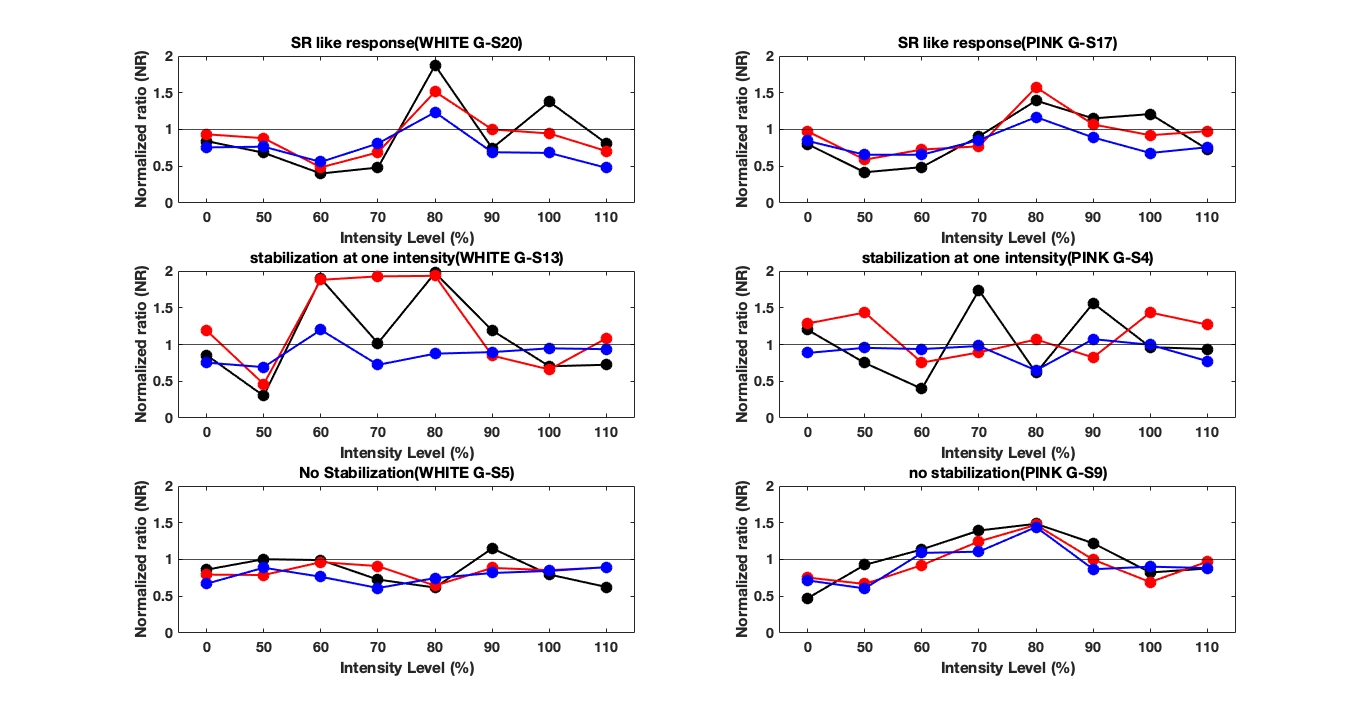Low (sub-threshold) levels of noisy vestibular stimulation (nVS) improve stability in healthy adults1. This has been explained by the stochastic resonance2 (SR) phenomenon according to which adding random noise to a non-linear system can enhance the detection and transmission of weak signals. However, for a system to exhibit SR behavior, stimulus-response data should follow a pseudorandom bell-shaped curve peaking at optimal levels for signal transmission3.
The objectives of the present study were a) employ an individual-based threshold detection approach to identify optimal stimulus intensity, b) examine if noise-induced reductions in postural sway align with Stochastic Resonance (SR) phenomenon, c) compare white and pink noise vestibular stimulation in inducing SR-like postural sway reductions.
Method: Forty-two (42) healthy young volunteers (15 males, 27 females, age 30.0 ± 9.0 years), were randomly divided into a group that received WHITE noise VS (n=22) and a group receiving PINK noise stimulation (n=20). Participants were fitted with a set of bipolar electrodes, with the cathode electrode always attached on the left mastoid. Stimuli were generated in LABView, sent to an analog output device (NI PCI-6221) and delivered to the participant after passing through an constant current isolator (A-M Systems). For the thresholding task, participants received, while seated, 10s bouts of nVS (zero-mean, Gaussian, 0-30 Hz) of increasing intensity in steps on 0.05 mΑ until they felt and verbally declared the stimulus onset and offset times for three successive stimuli bouts. This was defined as the individual perceptual threshold (PT) intensity. For the standing task, participants stood for 60 s on a force platform (Bertec Balance Plate, 100 Hz) with feet together and eyes closed. nVS was applied during the 2nd half of the trial (30 to 60s) at 7 intensities around the individual perceptual threshold (50%, 60%, 70%, 80%, 90%, 100% and 110% of threshold). A trial with sham stimulation was performed at the beginning of testing. Standing balance was quantified in the area, the root mean square (RMS) displacement and the mean velocity of the Centre of Pressure (CoP). A normalized ratio (NR) of the stimulus vs. the no stimulus period was calculated for each balance measure and this ratio was then subject to statistical analysis.
Results and conclusion: PT intensity was not different between the WHITE and PINK noise groups (p>.05). In standing, the NR did not change across stimulus intensities (p>.05) and was not different between groups except for the NR of CoP velocity that increased at 90% (p=.032) and 100% (p=.006) of PT for the PINK group. Most participants (95% of the WHITE and 75% of the PINK group) showed stabilization (NR<95% of CI) for 2/3 measures at one intensity at least1 (Figure 1). Nevertheless, only a minority of them (42% and 35% for the WHITE and PINK group respectively) exhibited an SR-like pseudo bell shaped response3. These results do not confirm a stabilizing effect of nVS but contribute to the ongoing discussion on optimal protocols for delivering nVS and further our understanding of the vestibular system's involvement in balance control.

